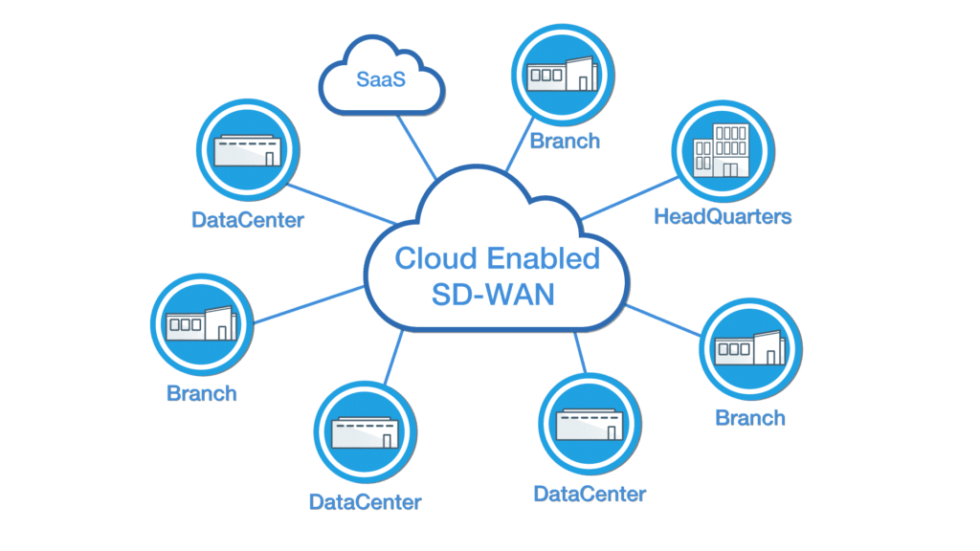What is SD-WAN?
As the landscape of IT continues to change rapidly, SD-WAN uses a combination of hardware, software and cloud‐based technologies to simplify the delivery of network services to different physical sites. The result is ultimate and seamless network accessibility for all team members, regardless of location.
Your MPLS Network.
Multiprotocol Label Switching, or MPLS, is likely the network technology your business is currently operating on.
Essentially, it is a physical set-up that directs data from one network node to the next, with all traffic going through a centralised data centre. It was designed to offer a speedy service and effectively manage traffic flows across enterprise-wide networks that may include multiple sites or branches.
Meeting the Demands of Remote Workers
However, with the ever increasing number of remote workers, mobile devices and applications today’s businesses rely on, existing MPLS networks can struggle to meet the demands of the modern-day company.
What if there was a different option, that could offer low levels of latency, high performance access to cloud applications, and the ability to meet the additional security and management requirements associated with decentralizing traffic flows?
That’s where SD-WAN comes in! This technology achieves all of the above, by incorporating a number of different commodity-grade links and intelligently routing traffic over your network. In effect, SD-WAN is a virtualized option that offers super low-latency and can be tailored to meet your organisation’s distinct needs.

Reducing Costs
Business can reduce costs by diverting traffic from MPLS to more cost-effective broadband alternatives in a hybrid WAN configuration.
SD-WAN makes it easy to achieve cost savings by automatically splitting traffic between low-cost, highly-available WAN links based on business needs and objectives.
This is possible because the SD-WAN solution can determine network traffic by application and then steer it according to policy-based rules.
It should be noted that SD-WAN is not a replacement for MPLS – rather, it can reduce the amount of MPLS bandwidth required (thereby reducing the associated cost) by using commodity-grade links (including cable, DSL and fibre) to carry specific traffic types.

Is SD-WAN a replacement for MPLS?
No, SD-WAN is not a replacement for MPLS.
In fact, it can be seamlessly integrated with your existing network.
Put quite simply, depending on what purpose an employee is using your network for, it might make more sense from them to use MPLS at one time, while at other times a traditional internet connection.
SD-WAN offers all of these options bundled together, and has the ability to intuitively switch between them.
Do I need to change network providers?
No you do not. SD-WAN is not a replacement for your current internet set up, but an enhancement of it.
It provides an entire pool of connectivity options for your business.
Think of SD-WAN as your overriding network, giving multiple choices for network access, allowing for boosted efficiency in operations, and the levels of connectivity required to meet the IT demands of a modern, multi-site business.
Will SD-WAN save my business money?
The simple answer is yes.
Picture SD-WAN as a physical box, containing all the hardware and software required for ultimate redundancy, eliminating downtime and thus increasing productivity.
The fact it is a virtualized option reduces the need for pricey hardware upgrades and the hefty equipment costs associated with traditional networks.
What’s more, by bundling together all the different means of accessing your network, you’ll receive greater bandwidth at lower costs.
What are the security implications of SD-WAN?
We understand that no business wants to compromise on security
While cloud applications do reside outside of the private enterprise network, the increase in accessibility, flexibility and agility offered means they have become a necessity for most businesses.
To mitigate security risks with a traditional MPLS network, additional expenditure on IT staff is required.
SD-WAN, meanwhile, offers the same levels of robust and secure connectivity to all business applications for the employee on the road as for the team at head office.
It uses standard based encryption to provide secure connectivity, thus creating a secure cloud network.
Is SD-WAN easy to manage?
Yes. SD-WAN solutions are designed to enable ease-of-adoption, use and management, and can be easily integrated with your existing MPLS network.
Its user-friendly interface ensures managing your network is simple, flexible and cost-effective.
Your team will be enabled to easily troubleshoot, reducing the time it takes to correct issues and increasing the productivity of your IT department.
By integrating SD-WAN into your business operations you will benefit from boosted levels of control over your network via the ability to prioritise traffic and seamlessly alter traffic flows.
How reliable is SD-WAN when it comes to cloud and SaaS applications?
The evolution of IT technologies and a workforce that increasingly comprises remote workers have significantly altered traffic flows for many businesses.
Remote staff still need direct access to SaaS and cloud‐based applications, but because MPLS networks transmit all traffic via a centralized data centre, latency and performance can sometimes suffer.
Additional security and management needs also result from disparate traffic flows, meaning increased operational costs.
On the other hand, SD-WAN has a distinct and clear advantage.
By providing multiple connectivity options and directing traffic through the most appropriate channels, it allows for improved agility, as bandwidth can be increased or reduced quickly, without the need for IT personnel to be deployed on‐site.
SD‐WAN leverages better internet access to provide secure, high‐performance connections to the cloud .